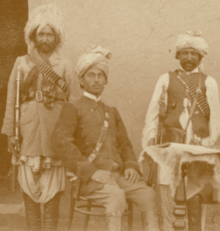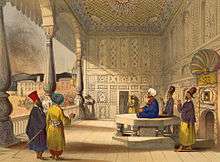Nasher (Kharoti clan)
The Nasher (or Nashir) (Dari: الناشر, Persian: الناشر, Arabic: الناشر) are a noble Afghan family and Khans of the Pashtun Kharoti (Ghilji) tribe.[1] The family is originally from Qarabagh, Ghazni but founded modern day Kunduz in the early 20th century and lived there until the end of the Barakzai dynasty in the late 20th century. Members of the family now live in the United States, in the United Kingdom, and in Germany.
| House of Nasher | |
|---|---|
 | |
| Parent house | Kharoti |
| Country | Afghanistan |
| Founded | 977 / 1709 |
| Titles | |
Origins and history


The Nasher are often linked to the ancient Ghaznavid dynasty.[2][3][4][5] The Ghaznavids (Persian: غزنویان) were a Turko-Persian dynasty of Mamluk origin who carved out an empire, at their greatest extent ruling large parts of Persia, much of Transoxania, and the northern parts of the Indian subcontinent from 977 to 1186 A.D.[6][7] When the Ghaznavid dynasty was defeated in 1148 by the Ghurids, the Ghaznavid Sultans continued to live in Ghazni.[2][3] It has been suggested that they became known as the Nasher though no evidence of continuous lineage has been found.
The earliest certain mention of the Nasher was in 1120 A.H (1709 A.D.),[5][8][9][10][11] when Ghilji Pashtun tribesmen under Khan Nasher successfully overthrew Safavid rule to establish the Ghilji Hotaki dynasty, which controlled Afghanistan from 1719-1729 A.D. and much of Persia from 1722-1729 until Nadir Shah of Persia seized power in the Battle of Damghan.
The above allegation historically seems to be included in various absurdities which one can find in different books written in Afghanistan after 1942, when the so-called "Afghanistan Historical Society" was founded. The Gahznavids were undoubtedly Turks, and the Kharuti Ghalzois (including the sub-clan 'Nasher') are Pashtuns, i.e. Pathans. Their history is shrouded in the mists of the times, but they are apparently a kind of nomadic tribe of unknown ancestry. The Zakhu Khail clan, like the rest of Kharutis, were originally coming to the Qarabagh plains in summers as seasonal nomads, while the Hazaras were the sedentary population. However, they gradually occupied the fertile lands and ousted the Hazaras by force (See p xx, Introduction, written by Robert McChesney, The History of Afghanistan (6 vols), Sirāj al-Tawarikh by Fayż Muḥammad Kātib Hazarah).
The Nasher (often referred to as Ghaznavid[4][5][8][9][12]) then lived as Khans of the Kharoti (Pashto: خروټی), a Pashtun tribe of Ghilji origin with an estimated population of about 5.5 million, making it one of the largest, if not the largest tribe in Afghanistan, with significant territory throughout eastern and south-eastern Afghanistan: Ghazni, Zabul, Paktia, Khost, Logar, Wardak, Kabul and Nangarhar.[13][14]
In the 19th century



After the great Ghilji rebellion in 1885-1886, led by Alam Khan Nasher, the Nasher family was exiled by the ruling Barakzai King Amir Abdur Rahman Khan in order to weaken his nemesis.[15] Sher Khan Nasher, Khan of the Kharoti soon became governor of the Kunduz district launched an industrialisation campaign, founding the Spinzar Company, with major urban development and construction programmes.[16][17] Economic development transformed Kunduz into a thriving city with new residential housing, schools, and hospitals for the factory workers.[18] Sher Khan Nasher also implemented Qizel Qala harbour that was later named Sher Khan Bandar in his honour.[19] As his power grew and he eventually controlled the whole north of Afghanistan, the throne was within his reach, which is why there are theories that he was poisoned by the Barakzai king.[20] Several schools were named after him,[21][22] with many high-profile graduates, such as Hekmatyar,[23][24] Farhad Darya Nasher,[25] Dr. Saddrudin Sahar[26] and Suleman Kakar[27] Muhammad Nasher Khan was the governor of Badakshan in the 1930s.
In modern history
Sher Khan's nephew and stepson Ghulam Sarwar Nasher developed Spinzar further, employing over 20,000 people and maintaining construction companies, a porcelain factory and hotels in Kunduz and throughout Afghanistan.[28] Long before he became a radical, Nashir sent fellow Kharoti Hekmatyar to Kabul's Mahtab Qala military academy in 1968, as he considered him to be a promising young man.[21][29] After he was expelled from the Mahtab Qala, Nasher imprisoned him briefly for toying with Communist ideology.
Discovery of Alexandria on the Oxus
On a hunting trip, Nashir discovered ancient artefacts of Ai Khanom and invited Princeton-archaeologist Daniel Schlumberger with his team to examine Ai-Khanoum.[30] It was soon found to be the historical Alexandria on the Oxus, also possibly later named اروکرتیه or Eucratidia), one of the primary cities of the Greco-Bactrian kingdom. Some of those artefects were displayed in Europe and USA museums in 2004.
Nashir was awarded "The Order of the Sacred Treasure" by the Emperor of Japan, in 1971, among other awards. The current governor of the Kunduz district is Nizamuddin Nasher Khan, considered to be the "last scion of a legendary Afghan dynasty" still living in Kunduz,[28][31] as members of the family are now mostly living in England, Germany, and the United States.
Notable Nasher
The most populer Afghan singer, Farhad Darya Nasher, is a grandson of Sher Khan.[25][32]
- Sher Khan Nasher Loe Khan (Grand Khan) founder of Spinzar Cotton Company and founding father of Kunduz
- Gholam Serwar Nasher Khan (1922–1984), president of Spinzar Cotton Company
- Gholam Nabi Nasher Khan (1926–2010), parliamentarian
- Gholam Rabani Nasher Khan (1940–), member of the Loya Jirga
- Farhad Darya Nasher Khan (1962–), singer and composer
- Jack Nasher Khan (1979-), business psychologist
Cities and places named after the Nasher
- Sher Khan Bandar, largest port of Afghanistan
- Qal`eh-ye Nasher
- Sher Khan High School, Kunduz
- Sher Khan Dry Port School, Northern Kunduz province
- Nasher Museum, Kunduz
References
- "Archived copy". Archived from the original on 2014-08-21. Retrieved 2014-09-16.CS1 maint: archived copy as title (link) http://www.khyber.org/tribes/info/Kharoti_a_Short_Note.shtml
- Meher, Jagmohan: Afghanistan: Dynamics of Survival, p. 29, at Google Books
- http://www.afghan-bios.info/index.php?option=com_afghanbios&id=556&task=view&total=2916&start=857&Itemid=2
- http://www.unique-design.net/library/mythos.html
- http://afghanembassy.com/viewtopic.asp?id=1331&t=Afghan%20Leaders%20Yearbook%5B%5D
- C.E. Bosworth, "Ghaznavids" in Encyclopaedia Iranica, Online Edition 2006
- C.E. Bosworth, "Ghaznavids", in Encyclopaedia of Islam, Online Edition; Brill, Leiden; 2006/2007
- http://www.rkabuli.20m.com/index_2.html
- "Archived copy". Archived from the original on 2010-01-31. Retrieved 2014-09-16.CS1 maint: archived copy as title (link)
- http://www.afghanland.com/history/leaders/leaders.html
- Runion, Meredith L.: The History of Afghanistan, p. 63, at Google Books
- http://ishratturi.blogspot.de
- Personalities: An Examination of the Tribes and the Significant People of a Traditional Pashtun Province - Timothy S. Timmons and Rashid Hassanpoor (2007)
- http://www.watan-afghanistan.de/unsereStaemme.html
- The Wars of Afghanistan: Messianic Terrorism, Tribal Conflicts, and the Failures of Great Powers, p. 42, at Google Books Peter Tomsen, PublicAffairs, 2011
- Wörmer, Nils (2012). "The Networks of Kunduz: A History of Conflict and Their Actors, from 1992 to 2001" (PDF). Stiftung Wissenschaft und Politik. Afghanistan Analysts Network. p. 8
- Grötzbach, Erwin: Afghanistan, eine geographische Landeskunde, Darmstadt 1990, p. 263
- Emadi, Hafizullah: Dynamics of Political Development in Afghanistan. The British, Russian, and American Invasions, p. 60, at Google Books
- Tanwir, Halim: AFGHANISTAN: History, Diplomacy and Journalism Volume 1, p. 253, at Google Books
- del Castill, Graciana: Guilty Party: The International Community in Afghanistan, p. 58, at Google Books
- Roy, O.; Sfeir, A.; King, J (eds.): The Columbia World Dictionary of Islamism, p. 130, at Google Books
- http://www.pajhwok.com/en/2011/03/03/school-building-constructed-kunduz
- http://publishing.cdlib.org/ucpressebooks/view?docId=ft7b69p12h;chunk.id=s1.17.8;doc.view=print
- Kakar, H.M.: The Soviet Invasion and the Afghan Response, 1979-1982, p. 307
- http://www.barnesandnoble.com/w/afghan-composers-books-llc/1027012611?ean=9781156384503
- "Archived copy". Archived from the original on 2015-04-05. Retrieved 2015-03-22.CS1 maint: archived copy as title (link)
- http://www.afghan-bios.info/index.php?option=com_afghanbios&id=2436&task=view&total=2916&start=1234&Itemid=2
- Reuter, Christoph: Power Plays in Afghanistan: Laying the Groundwork for Civil War, 49/2011 (Dec. 5, 2011) of DER SPIEGEL http://www.spiegel.de/international/world/power-plays-in-afghanistan-laying-the-groundwork-for-civil-war-a-801820-2.html
- Killing the Cranes: A Reporter's Journey through Three Decades of War in ...von Edward Girardet, p. 183, at Google Books
- Bernard, Paul: Aï Khanoum en Afghanistan hier (1964-1978) et aujourd'hui (2001), p. 971 www.persee.fr/web/revues/home/prescript/article/crai_0065-0536_2001_num_145_2_16315?_Prescripts_Search_tabs1=standard&
- http://warincontext.org/2012/07/03/how-the-u-s-has-handed-control-of-afghanistan-to-lawless-militias/
- "Archived copy". Archived from the original on 2014-12-13. Retrieved 2014-12-13.CS1 maint: archived copy as title (link)
Further reading
- Dupree, Louis: Afghanistan
- Emadi, Hafizullah: Dynamics of Political Development in Afghanistan. The British, Russian, and American Invasions
- Meher, Jagmohan: Afghanistan: Dynamics of Survival
- Runion, Meredith L.: The History of Afghanistan
- Tanwir, Halim M.: AFGHANISTAN: History, Diplomacy and Journalism
- An Introduction to the Commercial Law of Afghanistan, Second Edition, Afghanistan Legal Education Project (ALEP) at Stanford Law School
